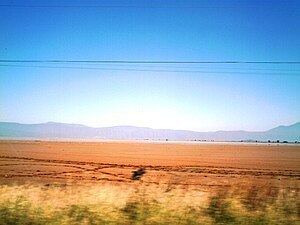Primary outflows Natural evaporation Average depth 2 m (6 ft 7 in) Surface elevation 1,350 m | Designated February 2, 2004 | |
 | ||
Primary inflows | ||
Laguna de Sayula ("Sayula Lake") is a lake located in the southern area of Jalisco, about 60 km from Guadalajara. It is located in the municipalities of Sayula, Zacoalco de Torres, Amacueca, Teocuitatlán de Corona, Atoyac and Techaluta de Montenegro.
Contents
- Map of Laguna de Sayula Jalisco Mexico
- Geographic location
- Hydrography of the lake
- Flora
- Fauna
- References
Map of Laguna de Sayula, Jalisco, Mexico
The lake level has gradually been lowering since 1994 but it still supports a large variety of wildlife.
Geographic location
Laguna de Sayula is found in the Zacoalco-Guzmán water system, right between the Tapalpa Mountains and the Mazamitla Mountains, in the central part of Southern Jalisco. The coordinates of its borders are:
It measures 168 km2 with a maximum width of 8.34 km and a minimum of 2 km and a maximum length of 31.17 km and a height of 1350 msnm. The lake has two islands, called Isla Chica ("small island") and Isla Grande ("big island"), of oval forms less that 1 km2. It has a coast approximately 90 km long and a depth of 2 meters.
One finds the municipalities of Sayula, Amacueca, Techaluta de Montenegro, and Atoyac around the lake.
Hydrography of the lake
Laguna de Sayula is a wetland with Ramsar (an important place for bird conservation), the wetlands are ecosystems where water is the main factor controlling the environment, vegetable life and animals associated with it. The lakes of the closed Sayula-Atotonilco basin form part of the endorheic lakes of the neo-volcanic axis. But Laguna de Sayula is especially important because of its relation to the migratory habitats of the North American birds.
Flora
Because the lake is salty, the vegetation found nearby is highly tolerant to salt. Along with these, there are low-lying vegetation that surrounds the lake.. The aquatic plants found in the lake is sparse, and can only be found in small pockets of freshwater in the area. The tropical deciduous forest vegetation can be found in higher altitudes, atop of hills and islands on the lake.
The flora that can be found around the lake includes:
Fauna
The wildlife found around the lake is very diverse; it's common to see birds in the winter, of the species Chen caerulescens, Chorlito tildío, and Charadrius vociferus, along with turtles, eagles, insects and hawks.
